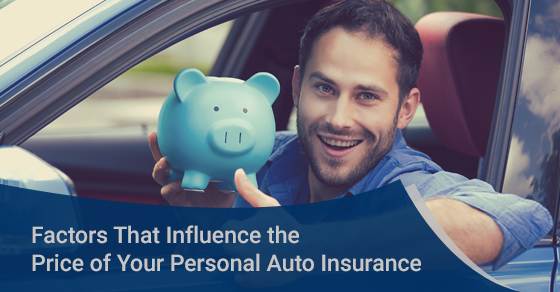
Factors That Influence the Price of Your Personal Auto Insurance
For the fifth time in a row, auto insurance rates increased by an average of 3.35% in Ontario in the fourth quarter of 2018. The changes were approved by the Financial Services Commission of Ontario (FSCO), which publishes rate changes in each quarter. As a result, many drivers in Ontario were required to pay higher rates during renewal, by 1.65% to 34.87%, depending on the insurer you’re using, and the specified rate change for that insurer.
In the third quarter (Q3) of 2018, auto insurance rates were increased by 2.06%. The rates had also been increased by 1.11% in Q2, 2.23% in Q1, and 1.03% in Q4 of 2017.
Technology and Distracted Driving to Blame
According to FSCO, the increase in auto insurance rates was due to increased claims costs for repairing modern vehicles that are technologically advanced, as well as the higher number of collisions attributed to distracted driving. Actually, these are the two biggest contributors to the increase in auto insurance premiums.
Another factor that influences how much you pay for your auto insurance is the place where you live. While the FSCO hopes to review this aspect in future, there are some Toronto-area MPPs who had introduced bills in late 2018 to: one, eliminate auto insurance pricing based on place of residence; and, two, to group the GTA, York, Peel, Halton, and Durham as a single geographic area when determining the rates.
Factors That Influence Your Auto Insurance
Maybe some changes will be implemented but at the moment, where you stay still affects your auto insurance premiums. Here is a closer look at the factors that influence your personal auto insurance premium in Oshawa:
Type of Car
The type of car you want to insure has a significant effect on your insurance rate in Ontario. Generally, high-tech brands and sports car will be more costly to insure due to the high cost of repairs, spares, or replacement in the event of a major breakdown, collision, or theft. Similarly, poorly maintained vehicles that are considered a hazard to other road-users may be expensive to insure due to the increased risk. At the same, classic vehicles may be cheaper to insure because they’re rarely on the road, and their owners are known to take good care of them.
Other car-related factors that may influence your insurance rates include:
- Safety rating
Vehicles with high safety rating are expected to be safer for the driver and passengers in the event of a collision or accident. This could imply that the vehicle is less likely to get into an accident due to some technological features, or that the passengers are less likely to be seriously injured in an accident. Some features that affect the safety rating include automatic seat belts, number of airbags, traction control, blind spot monitoring systems, lane-departure warnings, backup cameras, and adaptive cruise control. Drivers tend to receive discounts for various safety features, which can translate to very low insurance rates.
- The complexity of technology
Modern vehicles feature advanced technologies that make replacement parts and repairs very expensive. Although experts believe that different safety technology features work, there isn’t enough research on their effectiveness, and human error remains a significant factor in ensuring that these technologies work well. Moreover, more screens, lights, and warnings may distract the driver. All these factors may cause the insurance rate of your vehicle to increase.
- Size of vehicle
Larger vehicles are considered safer in collisions or accidents than smaller ones. So, a larger vehicle with a good safety rating will likely have lower premiums, but only to a certain extent. Larger engines attract higher rates, for example, V8 engines compared to V4 engines.
- Age of vehicle
Although the cost of repair of either an old and new car may be the same following an accident, it might not be worth repairing an old car if the repairs cost more than the actual value of the car. As such, it may be ‘totalled’ and replaced instead. A newer car, on the other hand, may be cheaper to repair. This may translate to higher collision coverage insurance rates for new vehicles compared to older ones.
- Likelihood of theft
Some vehicles are higher targets for thieves than others. Generally, vehicle models that get stolen a lot have higher premiums, though the rates can be discounted by installing anti-theft features and a car alarm.
Personal Factors
If you’re considered to be at risk of distracted driving and other acts of negligence, then your premium will be higher. Your age, driving record, and habits will affect your insurance rate. Generally, insurance premium drops when a driver turns 25 and continues to decrease the longer you’re licensed to drive.
That said, insurance is largely rated on an individual basis depending on your:
- Driving history
If you have received any tickets, got involved in accidents, received a DUI ticket, or made previous auto insurance claims, then your blemished record may make you a high-risk client, compared to a driver who has a clean record, resulting in higher premiums. If you have a very bad record, some insurers may completely refuse to insure you. However, these records are only considered for a limited period, so it’s important to cultivate good driving habits. - Driving activity
Factors such as the distance you drive, what you use your car for, and when or where you frequently drive will affect your insurance rates. Generally, you’re considered a higher risk the more time you spend on the road. Conversely, if you don’t drive a lot, you can enjoy a discount on your auto insurance.
Where You Live
Your place of residence also affects how much you pay for insurance. For instance, drivers who live in low-security areas with frequent cases of car theft and break-ins are likely to pay more, because insurance companies assume that your car will likely be targeted. Generally, insurance companies use reports on loss ratios provided for each postal code to determine the rates they will charge you.
The place you live also affects your auto insurance premiums in other ways, including:
- Population density
Most traffic accidents typically occur in your neighbourhood. If your community is densely populated, with more cars and activities, then you’re at higher risk of theft, accidents, and injury from collisions. - Cost of repair
Mechanic costs are not standard across the country or even province. Some places charge more due to the higher cost of living or higher rates of theft.
Auto insurance premiums are one of the major costs of owning a vehicle, so it’s important to take the necessary measures to lower your personal auto insurance rates in Oshawa whenever possible. You can also enjoy additional discounts if you purchase other types of insurance, like homeowner’s insurance, medical insurance, and so on as a bundle.
To learn more about the factors that influence your auto insurance, call WB White at (905) 576-6400 or contact us here.
Leave A Comment
The comments are closed.


